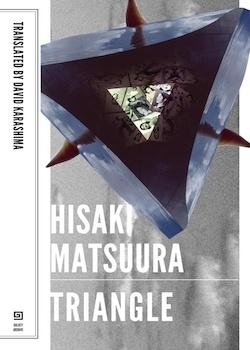Triangle

By Hisaki Matsuura
Translated by David Karashima
Dalkey Archive Press
1 April 2014, 350 pages
ISBN-10: 162897026X
Review by Chris Corker
Hisaki Matsura, a professor of French literature at the University of Tokyo, initially made his literary trade as a poet before moving onto novels. There are certainly elements of poetic symbolism and surrealism in sections of Triangle that reflect his earlier work. His 2000 novel A spoiling Rain won the Akutagawa prize in that same year, while his 2004 novel Peninsula, a follow-up to Triangle, won the Yomiuri Prize.
One thing that may be apparent to anyone familiar with the work of John Fowles is the striking similarity of Triangle to Fowles’ 1965 work The Magus. Certain events and concepts of timelessness, entrapment, helplessness and misdirected desire are mirrored throughout. And while the endings diverge and the setting is quite obviously different, the similarities are hard to ignore. The protagonists’ fatal flaws, however, are almost polar opposites. While Nicholas in The Magus is betrayed by his own arrogant assumptions and often brazenly wanders into traps laid for him obliviously, Otsuki, a former drug addict, is driven more out of a self-hatred and paranoiac fear at his own circumstances, falling in line with a self-destructive enthusiasm.
‘What was important was feeling comfortable with an idle lifestyle while maintaining a hatred for being a deadbeat.’
While this characteristic may be necessary for the reader to understand Otsuki’s persistence, when those of sounder mind may have stayed well away, it also makes it harder to sympathise with his character, as he wallows in his self-made squalor.
Despite the flaws with Otsuki’s character, the story is an intriguing one. While wondering through the maze-like Tokyo backstreets after an unfulfilling romantic affair with a married woman, Hiroko (who, as in the Magus, is transformed into tantalising bait), Otsuki is surprised to bump into one of his old colleagues, Sugimoto. Otsuki’s distaste and fear of this character is clear from the offset, and Sugimoto represents a seedy and nefarious past that Otsuki is ashamed of, trying unsuccessfully to forget and move beyond. Sugimoto implores Otsuki to meet his new boss, Koyama, who he refers to deferentially as ‘Sensei’. After much persuasion, Otsuki agrees. At Koyama’s house he is shown a pornographic film shortly after his arrival, in which images of hardcore sex are inter-spliced with grotesque images of feasting maggots and cannibalistic insects. Shortly after this aversion therapy-like film, which Koyama refers to uncompromisingly as ‘art’, Otsuki is asked to contribute his own directed scene, featuring Tomoe, a young girl he will come to desire and detest in equal measure. Here is highlighted the conflict in man of his baser instincts against his civilisation, his constant struggle to stand above other living things with an assumed transcendental nobility.
‘…Things of beauty, things of filth, they’re all the same when you burrow down to the core. If you descend to the depths, you reach a place where everything becomes one, a place where total opposites melt into each other completely. Beauty and pollution, life and death, lowliness and nobility, penis and vagina.’
From this point on events take a surreal and pernicious turn as Otsuki is sucked into a savage and convoluted maze, where each turn only offers more questions, or nothing at all. In-between each bizarre occurrence, Otsuki wanders through never-ending backstreets in the Tokyo summer heat, trying to find answers, or trying to find himself. There is a strong feeling throughout that everyone is implicit in the deception, further highlighting the isolated position of Otsuki and adding to the drama.
As the story is set in central Tokyo, anyone familiar with the city may recognise the names mentioned, such as Yotsuya, Asakusa and Shinjuku. In tone with Otsuki’s own desperate feelings are the economic times, the novel taking place slightly after the economic bubble has burst, leaving manual labourers out of work and destitute, the national mood sombre.
As mentioned before, there is a metaphysical element to the narrative, with philosophies on time similar to that which Vonnegut set out in Slaughterhouse 5 and a buried layer of existentialism. There is also a meditation on the art of Japanese Kanji, as Koyama tries to match the achievable perfection of the inanimate with the imperfect animate, but this will have little resonance with many western readers, and doesn’t always feel convincing. These elements, combined with the ongoing mystery and suspense of Otsuki’s journey encourage the reader to press on, searching for that answer that literary fiction often makes temptingly elusive. This narrative drive, however, does ebb away towards the final third of the novel, as it assumes a more conventional action narrative, the intrigue and introspection taking a back seat to a sequence of scenes that feel ill-fitted when compared to the rest of the novel, better suiting a Hollywood blockbuster.
Overall, Triangle is a brave and sometimes brutal novel that isn’t afraid to bend conventions and use the surreal to disorientate the reader. While its promise marginally outweighs its delivery, it is still a commendable, and for the most part, intriguing and addictive work.

